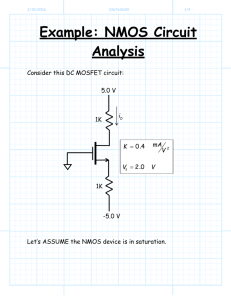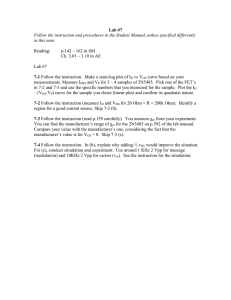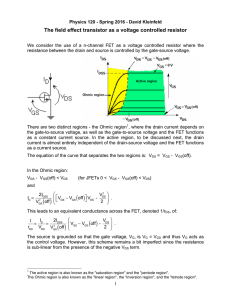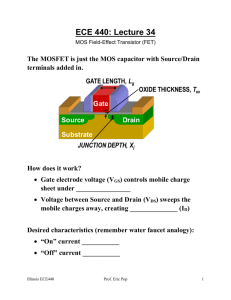Physics 120 Lab 7: Field Effect Transistors - Active region
advertisement
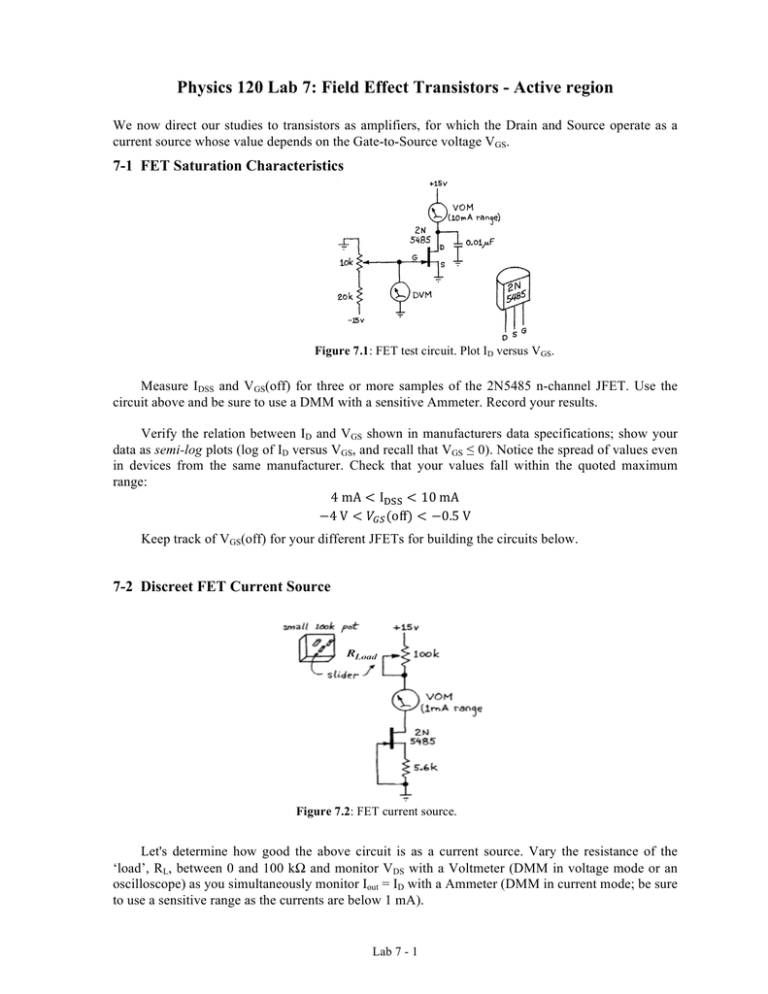
Physics 120 Lab 7: Field Effect Transistors - Active region We now direct our studies to transistors as amplifiers, for which the Drain and Source operate as a current source whose value depends on the Gate-to-Source voltage VGS. 7-1 FET Saturation Characteristics Figure 7.1: FET test circuit. Plot ID versus VGS. Measure IDSS and VGS(off) for three or more samples of the 2N5485 n-channel JFET. Use the circuit above and be sure to use a DMM with a sensitive Ammeter. Record your results. Verify the relation between ID and VGS shown in manufacturers data specifications; show your data as semi-log plots (log of ID versus VGS, and recall that VGS ≤ 0). Notice the spread of values even in devices from the same manufacturer. Check that your values fall within the quoted maximum range: 4 mA < I!"" < 10 mA −4 V < 𝑉!" (off) < −0.5 V Keep track of VGS(off) for your different JFETs for building the circuits below. 7-2 Discreet FET Current Source Figure 7.2: FET current source. Let's determine how good the above circuit is as a current source. Vary the resistance of the ‘load’, RL, between 0 and 100 kΩ and monitor VDS with a Voltmeter (DMM in voltage mode or an oscilloscope) as you simultaneously monitor Iout = ID with a Ammeter (DMM in current mode; be sure to use a sensitive range as the currents are below 1 mA). Lab 7 - 1 What is VDS when the constant current behavior starts to break down? Measure (use a DMM in voltage mode or the difference between two oscilloscope inputs) and report! This value of VDS marks the boundary of the "active region" and “Ohmic region” and should occur when VDS is near V!"! 𝑉!" (off). Does your FET’s “active region” begin around this value of VDS? Figure 7.3: Reminder: FET linear versus current-source regions depends on VDS. This circuit is a two-terminal current source that is, a current source that requires no external bias. It is also called "self leveling". 7.3 Improved Current Source Figure 7.4: Current source Recall the op-amp current source that you built in lab 5.5 (and shown above). This current source had the disadvantage of requiring a “floating” load, i.e., neither side connected to ground. The circuit below solves this problem and sources a current into a load connected to ground. Try it using a VP0104 p-channel MOSFET (note that the position of Drain and Source are reversed for p-channel and VGS < 0, i.e., the Source is at a higher potential than the Gate, which is at a higher potential than the Drain). Figure 7.5: Current source for load returned to ground. Lab 7 - 2 What is the expected value of Iout, the current through the load? What do you measure for a "light", i.e., low resistive, load Rload? Watch the variation in Iout as you vary Rload. To understand why the current source fails when it does, it may help to use a Voltmeter (or the difference between two oscilloscope channels) to watch the voltage across the FET, i.e., VDS. Present your result. Briefly discuss if the FET’s Ohmic region, i.e., the region with VDS below VGS - VGS(off), restricts the range of circuit performance as it did for the discrete FET current source (section 7.2)? 7-4 Simple source follower Figure 7.6: Source follower. Drive the source follower shown above with a small, i.e., 0.1 to 1.0 V sine wave at 1 kHz. By how much does the gain differ from unity. Show a SCREENSHOT. Why is there a difference? Infer gm, the transconductance at this 𝐼!!"#$%&$'( , from this single observation of the follower’s attenuation. One way to think of the effect of gm is to draw it as an equivalent resistance in the source: Figure 7.7: Effect of gm shown as series resistance forming voltage divider in a follower. Report your result and compare the gm that you infer from you follower’s attenuation with gm shown on the transistor’s data sheet. Recall that gm varies with ID and that the data sheet specifies gm under the most favorable condition, i.e., VGS = 0 V. Your follower runs with 𝑉!" < 0 𝑉, so the observed gm will always be lower than the data sheet’s value. This can be seen from curves for ID versus VGS and the gain = dIS/dVGS = dID/dVGS ≡ gm versus VGS. Since ID varies as the square of VGS, the gain curve looks like a straight line, reaching its maximum, and the specified value of gm, at IDSS, where VGS = 0. Lab 7 - 3 Figure 7.8: ID versus VGS, and gain versus VGS. Gain varies linearly with VGS – VGS(off). So, if you observe the quiescent value of VS, you know VGS-quiescent (VG rests at ground through the 1 MΩ pill-down resistor). Having measured VGS(off) at the start of today’s lab, you can see where you must be on the FET’s curve? Make a sketch. 7.5 Follower with Current Source Load Modify the circuit to include a current source load as shown in the figure below. Confirm that this follower performs much better than the simpler circuit. Figure 7.9: Low-Offset source follower with current source load Measure the gain with a 1 V, 1 kHz signal and document with a SCREENSHOT. Is the gain closer to 1.0 than with Simple Follower? Attempt to measure the input impedance. Document your work and report at least a lower bound. If you conclude that Rin is around 10 MΩ ohms, suspect that you have fallen into a trap! Measure the DC offset and document with a SCREENSHOT. What accounts for the non-zero offset? Mismatch of FETs? Mismatch of resistors? Anything else? What easy circuit changes would let you find out, if you are in doubt? Lab 7 - 4

